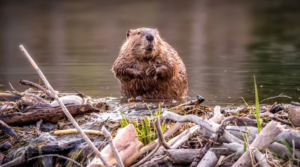Whenever I see an article with a headline like “Smarter ways to work with water” I am like a hound who catches a whiff and suddenly springs to attention. Or maybe one of those busy body old ladies who sit by their widow and lower their bifocals when they see that woman pulling up in the driveway with another new man.
I pay attention, but I don’t always expect to be please by the result.
Smarter ways with water
People need to find better and more productive ways to become allies with water — which might mean giving it space for its processes.
With mounting climate-fuelled weather disasters, social inequality, species extinctions and resource scarcity, some corporations have adopted sustainability programmes. One term in this realm is ‘circular economy’, in which practitioners aim to increase the efficiency and reuse of resources, including water — ideally making more goods (and more money) in the process.
Okay, I admit when I saw that the author was Erica Gies I got a lot more hopeful.
Working with wildlife
 Taking a holistic approach is also paying off in Washington state and in the United Kingdom, where people are allowing beavers space for their water needs. The rodents in turn protect people from droughts, wildfires and floods. Before people killed the majority of beavers, North America and Europe were much boggier, thanks to beaver dams that slowed water on the land, which gave the animals a wider area to travel, safe from land predators. Before the arrival of the Europeans, 10% of North America was covered in beaver-created, ecologically diverse wetlands.
Taking a holistic approach is also paying off in Washington state and in the United Kingdom, where people are allowing beavers space for their water needs. The rodents in turn protect people from droughts, wildfires and floods. Before people killed the majority of beavers, North America and Europe were much boggier, thanks to beaver dams that slowed water on the land, which gave the animals a wider area to travel, safe from land predators. Before the arrival of the Europeans, 10% of North America was covered in beaver-created, ecologically diverse wetlands.
Environmental scientist Benjamin Dittbrenner, at Northeastern University in Boston, Massachusetts, studied the work of beavers that were relocated from human-settled areas into wilder locations in Washington state. In the first year after relocation, beaver ponds created an average of 75 times more surface and groundwater storage per 100 metres of stream than did the control site9. As snowfall decreases with climate change, such beaver-enabled water storage will become more important. Dittbrenner found that the beaver’s work would increase summer water availability by 5% in historically snowy basins. That’s about 15 million cubic metres in just one basin, he estimates — almost one-quarter of the capacity of the Tolt Reservoir that serves Seattle, Washington.
I always have time to stop and enjoy a good Ben Dittbrenner reference. Yes lots of beavers doing their things all over would increase our available water. And help wildlife. And act as fire reduction. And reduce nitrogen.
But don’t listen to me.
Beavers have fire-fighting skills too, says Emily Fairfax, an ecohydrologist at California State University Channel Islands in Camarillo. When beavers are allowed to repopulate stretches of stream, the widened wet zone can create an important fire break. Their ponds raise the water table beyond the stream itself, making plants less flammable because they have increased access to water.
And beavers can actually help to prevent flooding. Their dams slow water, so it trickles out over an extended period of time, reducing peak flows that have been increasingly inundating streamside towns in England. Researchers from the University of Exeter, UK, found that during storms, peak flows were on average 30% lower in water leaving beaver dams than in sites without beaver dams10. These benefits held even in saturated, midwinter conditions.
Beaver ponds also help to scrub pollutants from the water and create habitats for other animals. The value for these services is around US$69,000 per square kilometre annually, says Fairfax. “If you let them just go bananas”, a beaver couple and their kits can engineer a mile of stream in a year, she says. Because beavers typically live 10 to 12 years, the value of a lifetime of work for two beavers would be $1.7 million, she says. And if we returned to having 100 million to 400 million beavers in North America, she adds, “then the numbers really start blowing up”.
But we love our pollution! We would so miss it! Said no one ever in the history of the world. Why not let beavers do what beavers do and start off on the right foot?
For the most part, mainstream economics doesn’t take into account the many crucial services provided by healthy, intact ecosystems: water generation, pollution mitigation, food production, crop pollination, flood protection and more.
Yup. We don’t put a price on the good things beavers do and what it actually cost us to continue killing them the way we do.. If we did it would blow our frickin’ minds.







































